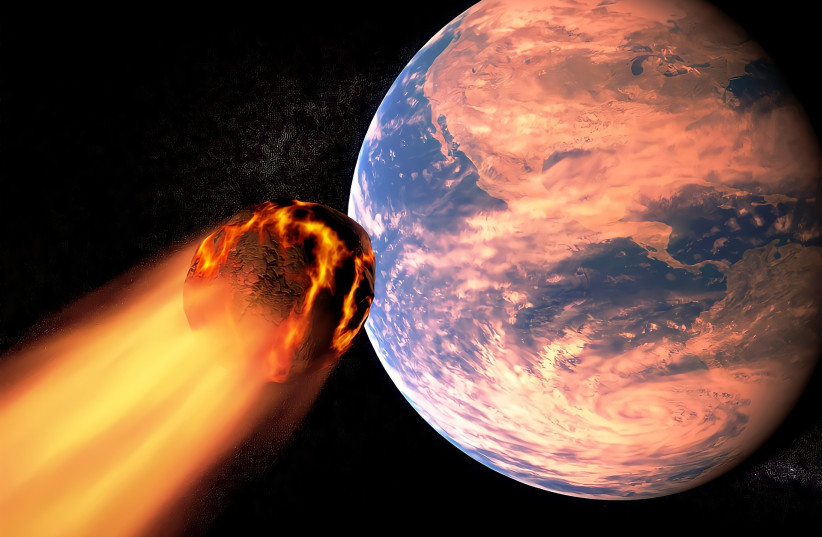Asteroid impacts remain one of the most dangerous possible natural disasters, but catastrophic collisions have been few in living memory. However, that was certainly not the case for Earth’s early years, when the young planet was furiously bombarded by massive ancient asteroids – 10 times more often than previously believed – and may have delayed the planet from being able to support life, a new study has revealed.
The impacts recorded in the study took place during the Archean eon, a period between 2.5 billion and 4 billion years ago. During this time, the planet’s environment was very different – and being bombarded by asteroids undoubtedly changed the landscape even further.
These were no small asteroids, either, with some of them around six miles (10 kilometers) in size.
For comparison, NASA has labeled any asteroid 140 meters or larger approaching the planet as a Potentially Hazardous Asteroid (PHA), due to having the potential to cause catastrophic damage to the Earth.
Asteroid impact: How can we stop one from happening? (credit: PIXABAY)
When these massive asteroids struck the planet, it resulted in the creation of impact spherules. These form when asteroid impacts melt and vaporize parts of the planet’s crust, causing them to form a giant plume above the surface before the molten rock condenses and solidifies. It would then fall back to the planet as particles the size of grains of sand, settling into the crust. The more layers of impact spherules there are, the more impacts there would have been.
These are very difficult to find, but discoveries made in recent years have increased scientific understanding of the number of impact events during this period.
But the influence these asteroid impacts had may go far beyond simply causing destruction to the landscape. In fact, they may have altered the very chemistry of the atmosphere.
THE ARCHEAN eon was the period in which life first began to form on Earth, as well as the slow accumulation of oxygen in the atmosphere.
Oxygen itself was not present in the atmosphere in any significant amount until the early Proterozoic era 2.5 billion to 541 million years ago, after anaerobic algae released it during photosynthesis.
But it is now thought to be possible that oxygen could have accumulated earlier – had it not been for these asteroids.

This is because the asteroid impacts produce reactive gases, which can snuff out low levels of oxygen in the atmosphere.
But as time went on and bombardments were less frequent, oxygen levels in the atmosphere began to rise, in what was known as the Great Oxidation Event (GOE).
“Impact vapors caused episodic low oxygen levels for large spans of time preceding the GOE,” Marchi said. “As time went on, collisions become progressively less frequent and too small to be able to significantly alter post-GOE oxygen levels. The Earth was on its course to become the current planet.”
THE DESTRUCTIVE nature of asteroids, even small ones, is something well-known to experts, with space agencies around the world monitoring for potential catastrophic impacts, as well as researching potential means of stopping them.
In layman’s terms, it means punching an asteroid with a rocket with enough speed to change its direction by a fraction of a percent.
However, this method does have its flaws, most notably timing. The spacecraft used in the DART mission has taken a considerably long amount of time and resources to develop and launch. In case of an asteroid impact that seems so sudden, that kind of time could be a luxury the planet can’t afford.
The science behind this method seems sound, though it also has its flaws, such as being able to deflect the asteroid when it’s far enough away from the planet. That could hypothetically mean over six months away.
The fragments would then be spread out into a cloud of fragments and, if not blown completely off course, would then head into the Earth’s atmosphere at speeds of around Mach 60.
But this is where the Earth’s atmosphere kicks in, as entering the atmosphere at such a high speed causes it to experience severe levels of heat and pressure. These stresses would in turn cause the fragments to explode further, creating a sonic boom of sorts.
This may seem terrifying to some, because, as noted by the scientists involved in the study, it would seem similar to the explosion of a thermonuclear bomb. But it would only be a large and harmless “light and sound” show, so there is no nuclear radiation risk. Dust could still be present, but it would not be so catastrophic as to cause a worldwide climate disaster scenario.